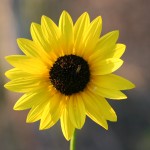Common Sunflower, Annual Sunflower
Helianthus annuus L.
Asteraceae (Sunflower Family)
Description
This tall, showy plant grows from 1.5 to 8 feet or 0.45 to 2.4 m tall. Its stem has short, prickly hairs and may sometimes be purple or dark colored. The leaves are covered in coarse, rough hairs, are located alternately along the stem, and may be toothed. The leaf blades can grow to 10 inches or 25 cm long. The flower heads are terminal (i.e., growing at the end of a branch or stem) and large, reaching up to 5 inches or 13 cm across. The ray flowers are yellow and the disk flowers brown. The plant blooms from July through October. The forage value of Common Sunflower for livestock is poor, but it provides an excellent food source for birds. Seeds may be consumed by birds, small mammals, and insects. Sunflowers can provide a good cover source for many wildlife species when intermixed with other annual plants.Habitat
This plant grows in many soil types and moisture conditions. It is prominent in disturbed and low-lying areas but can also persist in dry soils. Native habitats include prairies, grasslands, old field sites, roadsides, railroad edges, savannas, and woodland edges.Images
Plant Characteristics
Flower Color: Yellow
Seed Type: Non-Encapsulated
Duration: Annual
Stem Texture: Hairy
Growth Habit: Forbs/Broadleaf
Leaf Shape
 : Simple with Pinnate or Parallel Venation
: Simple with Pinnate or Parallel Venation
Season: Warm
Distribution
 : 01 - Pineywoods, 02 - Gulf Prairies and Marshes, 03 - Post Oak Savannah, 04 - Blackland Prairies, 05 - Cross Timbers and Prairies, 06 - South Texas Plains, 07 - Edwards Plateau, 08 - Rolling Plains, 09 - High Plains, 10 - Trans-Pecos
: 01 - Pineywoods, 02 - Gulf Prairies and Marshes, 03 - Post Oak Savannah, 04 - Blackland Prairies, 05 - Cross Timbers and Prairies, 06 - South Texas Plains, 07 - Edwards Plateau, 08 - Rolling Plains, 09 - High Plains, 10 - Trans-Pecos
Distributions
Distribution refers to the ecological region in Texas that a plant has been found. You can also view a clickable map.
Book: Brush and Weeds of Texas Rangelands (B-6208)
Collection: Brush and Weeds, Wild Flowers





